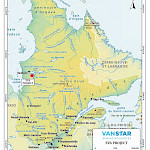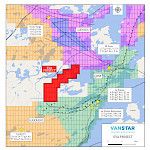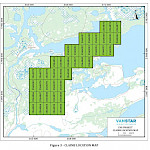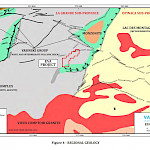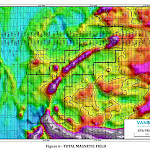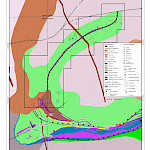The Eva property is located within the central part of the Superior Geological Province, which comprises four Sub-provinces: from north to south, they are the La Grande, Opinaca, Nemiscau and Opatica (Figure 4). Stratigraphy of the immediate area of Sakami Lake was well described by Goutier et al. (RG 99-15).
The La Grande Subprovince, defined as a volcano-plutonic assemblage, is characterized by narrow, sinuous, and partly interconnected greenstone belts surrounded and intruded by voluminous granitoid rocks. Structural trends are predominantly east-west to southeast-northwest. The subprovince consists of, from bottom to top, the Tonalite Langelier Complex (basement) dated to 2,778 ± 4 Ma, a mature arenitic sedimentary sequence (Apple formation) surmounted by a volcano-sedimentary sequence composed mainly of tholeiitic basalts, felsic volcanoclastites (dated to 2,732 Ma), and iron formations interbedded with sedimentary horizons (Yasinski group). These volcano-sedimentary sequences are cut by a series of intrusions of tonalite, diorite, monzodiorite, syenite (Duncan group, 2,709 Ma) and later ultramafics.
The Opinaca subprovince is a metasedimentary and plutonic subprovince located in the center of the Superior province between the Opatica subprovince and La Grande subprovince. The Opinaca subprovince is dominantly a sedimentary sequence of younger (≈2,618 Ma) clastic turbidites belonging to a much larger sedimentary basin (Laguiche basin). Polydeformed schists occur at the subprovince margins, whereas the interior portions are metamorphosed to amphibolite and granulite facies. The sedimentary units are commonly intruded by granodiorite, tonalite and pegmatite dykes.
According to the chronology of structural events from Goutier (RG 99-15), the first deformation episode, before the setting of the supracrustal unit, is visible into the tonalitic gneiss of the Langelier Complex. A second episode affects the volcano-sedimentary sequence of Apple-Yasinski. It is associated to a NW-SE tectonic movement and is responsible for kilometrical folding and imbrications. After the Duncan intrusion, which is associated with the third deformation, and the foliation of the intrusive units, a thrust fault brought the volcano-sedimentary unit in part over the metasediments of the Laguiche Group. Finally, a dextral (NW-SE) shear system affected the dome and basin structure.
The regional metamorphism varies gradually from the green schist facies in the North to the amphibolitic facies in the south. This progression is mostly observable through the metasediments of the Laguiche Group.


